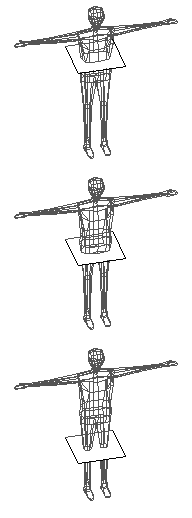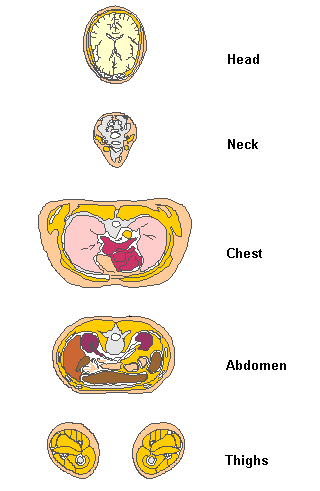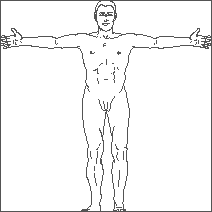| |

| |
The idea of the Timepiece dates back to 1981, and the unconventional placement of the column in Masolino da Panicale's The Annunciation provided the initial inspiration. The placement appeared awkward, yet, nonetheless intentional. The column creates an obvious duality that clearly symbolized the division between humanity and divinity. The distinct duality of the painting instigated further thinking about other dualistic circumstances and their possible relationship to the Annunciation, in general, and Masolino's painting, in particular. A connection between the two legs of the body and the dualistic relationship between God and humanity unexpectedly clicked, especially since both examples converge on a specific point that involves sex and birth. The juncture of a point in time and a point on the body immediately implies a relationship between the body and history, and the direct link of Christ's birth and the historical concept of A.D. and B.C. only reinforced the potential chronosomatic relationship. All at once, it became possible to speculate how other parts of the body might also have a metaphorical relationship to events in history.
It may or may not be significant that the conception of the Timepiece of Humanity occurred during an analysis of a painting that portrays the conception of Christ. Unfortunately, there is nothing that proves the physical and metaphysical aspects of the Christ event. The reality of Christ, and all He represents, relies entirely on religious faith, and, of course, not everyone shares in this faith. Nevertheless, the Christ event strikes a universal chord. It literally embodies the long standing and globally pervasive mythological concept of humanity returning to a primordial state of oneness with a higher being. Moreover, Christianity is the only world religion to claim an overt union between divinity and the human body. It is this focus on the human body that produces the principle affinity between Christianity and the Timepiece of Humanity, but this affinity does not make the Timepiece of Humanity a strictly Christian metaphor.
A deeper exploration of the Timepiece discloses an engagement of all the world religions. One example involves both Judaism and Christianity. There is a likeness between the Timepiece and King Nebuchodonosor's dream3 in the biblical Book of Daniel. Nebuchodonosar dreamt of a huge statue of a man, where different parts of the statue's body corresponded to different materials: the head was pure gold; the chest and arms were silver; the belly and thighs were bronze; the legs were iron; the feet were iron and clay. A stone, that came from nowhere, struck the feet of the statue, and the statue fell to pieces. In Daniel's interpretation of the dream, each of the different materials of the statue represented a different kingdom on earth. The gold represented Nebuchodonosar's kingdom, and the lesser materials represented weaker kingdoms that would follow in time. The kingdom of iron and clay at the feet represented a divided kingdom that was partly strong and partly fragile. Daniel's interpretations that feet symbolize division and that iron and clay symbolize strong and fragile are prototypical of the Timepiece of Humanity's method of interpretation; a method that derives meaning from morphology and physiology.
A second example involves Yoga, an Indian philosophy and late development of Hinduism. Yoga, or more specifically Hatha Yoga4, is a physiological theory that teaches the existence of a dormant divine potency at the base of the spine. Along the spine there are seven psychic centers, or chakras, and each center corresponds to a different part of the body: the lowest center is at the base of the spine; the second center is about 3 centimeters below the navel; the third center is near the solar plexus; the fourth center is at the sternum; the fifth center is at the throat; the sixth center is between the eye brows; the seventh center is at the crown of the head. Each chakra derives its specific characteristics from the physiological aspects of the body parts to which they correspond, and it is Yoga's overall focus on the human body's morphology and physiology that establishes an affinity between Hinduism and the Timepiece.
|
| |
3. I have found a man among the Judean captives who can give the interpretation to the king." The king asked Daniel, whose name was Baltassar, "Can you tell me the dream that I had, and its meaning?" In the king's presence Daniel made this reply:
The mystery about which the king has inquired, the wise men, enchanters, magicians and astrologers could not explain to the king. But there is a God in heaven who reveals mysteries, and he has shown King Nabuchodonosor what is to happen in days to come; this was the dream you saw as you lay in bed. To you in your bed there came thoughts about what should happen in the future, and he who reveals mysteries showed you what is to be. To me also this mystery has also been revealed; not that I am wiser than any other living person, but in order that its meaning may be made known to the king, that you may understand the thoughts in your own mind.
In your vision, O king, you saw a statue, very large and exceedingly bright, terrifying in appearance as it stood before you. The head of the statue was pure gold, its chest and arms were silver, its belly and thighs bronze, the legs iron, its feet partly iron and partly tile. While you looked at the statue, a stone which was hewn from a mountain without a hand being put to it, struck its iron and tile feet, breaking them in pieces. The iron, tile, bronze, silver, and gold all crumbled at once, fine as the chaff on the threshing floor in summer, and the wind blew them away without leaving a trace. But the stone that struck the statue became a great mountain and filled the whole earth.
This was the dream; the interpretation we shall also give in the king's presence. You, O king, are the king of kings; to you the God of heaven has given dominion and strength, power and glory; men, wild beasts, and birds of the air, wherever they may dwell, he has handed over to you, making you ruler over them all; you are the head of gold. Another kingdom shall take your place, inferior to yours, then a third kingdom, of bronze, which shall rule over the whole earth. There shall be a fourth kingdom, strong as iron; it shall break in pieces and subdue all these others, just as iron breaks in pieces and cruches everything else. The feet and toes you saw, partly of potter's tile and partly of iron, mean that it shall be a divided kingdom, yet still have some of the hardness of iron. As you saw the iron mixed with clay tile, and the toes partly iron and partly tile, the kingdom shall be partly strong and partly fragile. The iron mixed with clay tile means that they shall seal their allience by intermarriage, but they shall not stay united, any more than iron mixes with clay. In the life-time of those kings the God of heaven will set up a kingdom that shall never be destroyed or delivered up to another people; rather it shall break in pieces all these kingdoms and put an end to them, and it shall stand forever. That is the meaning of the stone you saw hewn from the mountain without a hand being put to it, which broke in pieces the tile, iron, bronze, silver, and gold. The great God has revealed to the king what shall be in the future; this is exactly what you dreamed, and its meaning is sure.
The Book of Danial 2:25-46
4. The seven chakras are located along a central axis corresponding to the spinal column of the physical body. As reflected in the physical realm, they are each thought to control the physiological functioning of a certain biological system. In the astral realm each chakra is associated with a certain set of emotions, psychic tendencies, and nonsensory forms of perception/consciousness. In the causal realm, they are associated with increasingly unified experiences of reality.
The lowest of the chakras, the muladhara, sits at the base of the spine. The muladhara allegedly houses a very powerful form of energy known in Sanskrit as the kundalini. According to yogic teaching, kundalini is the a priori life force which in its original state is a part of the Absolute. It is the force that acts to mold each human being into his or her individual form, which after it dwells asleep on the higher planes while continuing to work to a limited extent in the physical dimension. One quick but sometimes dangerous system of spiritual evolution is to reawaken the kundalini through a set of specially designed ascetic practices. The activated kundalini rises through the chakras, awakening each as it proceeds, until at last it reaches the topmost chakra at the crown of the head, where unification with the Absolute takes place.
The second center is called the swadhistana; it is located about 3 centimeters below the navel. This chakra governs the sexual functions and eliminatory processes. Physically, it is connected to the deeply rooted instinctive drives of the unconscious. When it is activated, the most noticeable change it produces is an abundance of energy, an increase in physical stamina, and a general improvement of overall health.
The third chakra, the manipura (spleen), is positioned near the solar plexus of the physical body. This center is said to govern a large portion of the individual unconscious and the digestive system. Included in its territory are the desire for power, the emotions, dreams, simple ESP, and clairvoyance.
The anahata (heart) chakra, located at the sternum, reputedly governs the heart and circulatory system, the beginning of a more far-reaching clairvoyance, and controlled psychokinetic power. This center, in its highly developed aspect, is the first that can truly be called spiritual; it is connected to forms of consciousness that transcend sensory-created distinctions and consequent egoistic desires--hence its association with universal love, with compassion free from vested interest. Awakening the anahata chakra brings a feeling of great expansion, the experience of moving beyond the tight shell of the small self. Higher mental faculties begin to come into play. Intuitive understanding of the real relationships among seemingly diverse elements of nature occurs, producing the type of intuitive leaps exhibited by artistic or scientific genius.
After this center has been awakened, if the lower centers are sufficiently purified (i.e., emptied of unconscious content), the experiencer will feel little attachment to the sensory or emotional realms. An ardent desire is born, however, that all beings develop to the point where they are equally as joyous in the realization of the interconnectedness and unity of all things.
The higher chakras are the visshuda (at the throat), the anja (between the eyebrows, and the sahasrara (at the crown of the head). Physically, the throat center is said to control respiration, the brow center to regulate the pineal and the pituitary glands; the sahasrara center, in the cerebral cortex, is considered the overseer and coordinator of the entire physiological system. To awaken the throat chakra one must abandon all desire and attachment to the material world; one may then function primarily in the causal realm.
The knowledge gained through the awakening of the three higher chakras surpasses the comprehension of the sensory-dependent intellect, as do the associated abilities. These are the level at which true universal understanding takes place which many mystics hold to be the ultimate goal of the human adventure.
Hiroshi Motoyama, Science and the Evolution of Consciousness (Brookline: Autumn Press, Inc., 1978), pp. 86-90.
|



